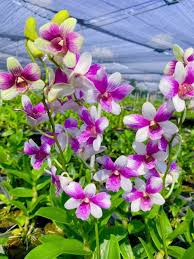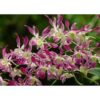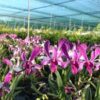# Growth and Development Characteristics of Dendrobium Orchids

Dendrobium orchids, belonging to the Orchidaceae family, are one of the most diverse and popular genera of orchids. Known for their stunning flowers and varying sizes, they are found in a variety of environments across Southeast Asia and beyond. Understanding the growth and development characteristics of Dendrobium orchids is essential for successful cultivation and care. This article will explore the various aspects of their growth, including environmental requirements, growth stages, care techniques, and common challenges faced by growers.
## 1. Overview of Dendrobium Orchids
### 1.1 Taxonomy and Diversity
Dendrobium is one of the largest genera within the Orchid family, comprising approximately 1,800 species. They are commonly found in tropical and subtropical regions, with a significant number of species native to Australia and Southeast Asia. Dendrobium orchids exhibit a wide range of forms, colors, and sizes, making them a favorite among orchid enthusiasts.
### 1.2 Unique Characteristics
Dendrobium orchids are characterized by their distinctive pseudobulbs, which store water and nutrients. The leaves, which can be narrow or broad depending on the species, grow from the pseudobulbs. These orchids typically bloom once a year, producing flowers that can last several weeks to months. Flower colors range from white and yellow to purple and red, often with intricate patterns.
## 2. Growth Conditions
### 2.1 Light Requirements
Dendrobium orchids thrive in bright, indirect light. While they can tolerate some direct sunlight, excessive exposure can lead to leaf burn. In their natural habitat, they grow in the understory of forests where they receive filtered light. For indoor cultivation, placing them near east or west-facing windows is ideal. During the flowering period, they benefit from increased light levels, which can enhance blooming.
### 2.2 Temperature Preferences
Temperature plays a critical role in the growth and development of Dendrobium orchids. They prefer a temperature range of 65°F to 85°F (18°C to 29°C) during the day and slightly cooler temperatures at night. Some species can tolerate lower temperatures, while others require warmer conditions. It’s essential to maintain a consistent temperature to promote healthy growth.
### 2.3 Humidity Levels
Dendrobium orchids thrive in humid environments, ideally between 50% and 70% humidity. Inadequate humidity can lead to dehydration and poor growth. To maintain humidity levels, consider using a humidifier, placing a tray of water near the orchids, or misting the plants regularly. During the winter months, when indoor heating can lower humidity, extra measures may be necessary.
### 2.4 Watering Needs
Proper watering is crucial for the growth of Dendrobium orchids. They prefer to dry out slightly between waterings, as overwatering can lead to root rot. Watering frequency may vary depending on the season and environmental conditions. In general, water once a week during the growing season and reduce frequency during the dormant period. Always use room-temperature water and ensure proper drainage to prevent waterlogging.
### 2.5 Nutrient Requirements
Dendrobium orchids benefit from regular fertilization during the growing season. A balanced, water-soluble fertilizer with an N-P-K ratio of 30-10-10 is often recommended. Fertilizing every two to four weeks can promote healthy growth and flowering. It’s essential to dilute the fertilizer to half-strength to avoid burning the roots.
## 3. Growth Stages
### 3.1 Germination and Seedling Stage
Dendrobium orchids typically start their life cycle from seeds. Orchid seeds are extremely small and lack the necessary nutrients to grow independently. In nature, they require a symbiotic relationship with specific fungi for germination. For cultivation, seeds can be germinated in a sterile medium, such as agar, in a controlled environment.
Once germinated, seedlings require high humidity and moderate light to thrive. This stage can last several months to a few years, depending on the species and growing conditions. Seedlings should be repotted into larger containers as they grow to prevent overcrowding.
### 3.2 Vegetative Growth
After the seedling stage, Dendrobium orchids enter the vegetative growth phase. During this time, they produce pseudobulbs and leaves, which are vital for photosynthesis and nutrient storage. This phase typically occurs in spring and summer, coinciding with favorable environmental conditions.
Growers should ensure that the orchids receive adequate light, humidity, and water during this phase to promote healthy growth. Pseudobulbs will continue to grow until they reach maturity, after which they will start the flowering process.
### 3.3 Flowering Stage
The flowering stage is the most anticipated phase for orchid growers. Dendrobium orchids typically bloom once a year, with the timing depending on the species and environmental conditions. To encourage blooming, it’s essential to provide the right combination of light, temperature, and nutrition.
When flowers begin to develop, they can last anywhere from several weeks to a few months, depending on the species and growing conditions. After blooming, the flowers will eventually fall off, and the plant will return to its vegetative growth stage.
## 4. Care Techniques
### 4.1 Potting and Repotting
Potting Dendrobium orchids in the right medium is crucial for their growth. A well-draining orchid mix, often consisting of bark, perlite, and sphagnum moss, is recommended. Repotting should be done every 1-2 years or when the medium breaks down, which can affect drainage and moisture retention.
When repotting, gently remove the plant from its pot and trim any dead or damaged roots. Place the orchid in the new pot, ensuring the pseudobulbs are above the medium, and secure it lightly.
### 4.2 Pest and Disease Management
Dendrobium orchids can be susceptible to pests such as aphids, mealybugs, and spider mites. Regularly inspect your plants for signs of infestation. If pests are found, treat them promptly using insecticidal soap or neem oil. Additionally, keeping the growing area clean and free of debris can help prevent infestations.
Diseases such as root rot and fungal infections can also affect Dendrobium orchids. Overwatering and poor drainage are common causes of root rot. To prevent this, ensure that pots have drainage holes and allow the medium to dry slightly between waterings.
### 4.3 Providing Support
As Dendrobium orchids grow, they may require support to prevent the pseudobulbs from bending or breaking. Using stakes or trellises can provide the necessary support, especially during the flowering stage when the weight of the flowers can affect stability.
## 5. Challenges in Growth and Development
### 5.1 Environmental Stress
Environmental stressors such as temperature fluctuations, low humidity, and insufficient light can adversely affect Dendrobium orchids. Monitoring and adjusting the growing conditions regularly can help mitigate these issues. If growing indoors, consider using grow lights or a humidifier to maintain optimal conditions.
### 5.2 Nutrient Deficiencies
Dendrobium orchids may exhibit signs of nutrient deficiencies, such as yellowing leaves or poor growth. Regular fertilization and monitoring the health of the plants can help prevent these issues. If deficiencies are suspected, a balanced fertilizer can be applied, and soil tests can be conducted to determine specific nutrient needs.
### 5.3 Flowering Issues
Many growers experience difficulties getting their Dendrobium orchids to bloom. Factors such as inadequate light, improper watering, and lack of a temperature drop during the night can hinder flowering. To encourage blooms, ensure that the plants receive sufficient light and are given a rest period with reduced watering after flowering.
## 6. Conclusion
Dendrobium orchids are a fascinating genus with unique growth and development characteristics that make them popular among plant enthusiasts. Understanding their environmental needs, growth stages, and care techniques is essential for successful cultivation. By providing optimal growing conditions and addressing potential challenges, growers can enjoy the beauty of Dendrobium orchids in their homes and gardens. With their stunning blooms and diversity, these orchids continue to captivate and inspire individuals worldwide, making them a treasured addition to any plant collection.

